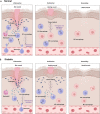Epigenetic regulation of macrophage polarization in wound healing
- PMID: 36687556
- PMCID: PMC9844119
- DOI: 10.1093/burnst/tkac057
Epigenetic regulation of macrophage polarization in wound healing
Abstract
The immune microenvironment plays a critical role in regulating skin wound healing. Macrophages, the main component of infiltrating inflammatory cells, play a pivotal role in shaping the immune microenvironment in the process of skin wound healing. Macrophages comprise the classic proinflammatory M1 subtype and anti-inflammatory M2 population. In the early inflammatory phase of skin wound closure, M1-like macrophages initiate and amplify the local inflammatory response to disinfect the injured tissue. In the late tissue-repairing phase, M2 macrophages are predominant in wound tissue and limit local inflammation to promote tissue repair. The biological function of macrophages is tightly linked with epigenomic organization. Transcription factors are essential for macrophage polarization. Epigenetic modification of transcription factors determines the heterogeneity of macrophages. In contrast, transcription factors also regulate the expression of epigenetic enzymes. Both transcription factors and epigenetic enzymes form a complex network that regulates the plasticity of macrophages. Here, we describe the latest knowledge concerning the potential epigenetic mechanisms that precisely regulate the biological function of macrophages and their effects on skin wound healing.
Keywords: Epigenetics; Immune microenvironment; Macrophage polarization; Signaling pathways; Wound healing.
© The Author(s) 2023. Published by Oxford University Press.
Figures



Similar articles
-
P311 Promotes IL-4 Receptor‒Mediated M2 Polarization of Macrophages to Enhance Angiogenesis for Efficient Skin Wound Healing.J Invest Dermatol. 2023 Apr;143(4):648-660.e6. doi: 10.1016/j.jid.2022.09.659. Epub 2022 Oct 26. J Invest Dermatol. 2023. PMID: 36309321
-
Macrophage-Mediated Inflammation in Skin Wound Healing.Cells. 2022 Sep 21;11(19):2953. doi: 10.3390/cells11192953. Cells. 2022. PMID: 36230913 Free PMC article. Review.
-
Aligned electrospun poly(L-lactide) nanofibers facilitate wound healing by inhibiting macrophage M1 polarization via the JAK-STAT and NF-κB pathways.J Nanobiotechnology. 2022 Jul 26;20(1):342. doi: 10.1186/s12951-022-01549-9. J Nanobiotechnology. 2022. PMID: 35883095 Free PMC article.
-
Fibrous scaffolds loaded with BMSC-derived apoptotic vesicles promote wound healing by inducing macrophage polarization.Genes Dis. 2024 Aug 9;12(2):101388. doi: 10.1016/j.gendis.2024.101388. eCollection 2025 Mar. Genes Dis. 2024. PMID: 39759117 Free PMC article.
-
Regulation of Macrophage Polarization and Wound Healing.Adv Wound Care (New Rochelle). 2012 Feb;1(1):10-16. doi: 10.1089/wound.2011.0307. Adv Wound Care (New Rochelle). 2012. PMID: 24527272 Free PMC article. Review.
Cited by
-
ROS-scavenging materials for skin wound healing: advancements and applications.Front Bioeng Biotechnol. 2023 Dec 12;11:1304835. doi: 10.3389/fbioe.2023.1304835. eCollection 2023. Front Bioeng Biotechnol. 2023. PMID: 38149175 Free PMC article. Review.
-
Modelling of macrophage responses to biomaterials in vitro: state-of-the-art and the need for the improvement.Front Immunol. 2024 Mar 26;15:1349461. doi: 10.3389/fimmu.2024.1349461. eCollection 2024. Front Immunol. 2024. PMID: 38596667 Free PMC article. Review.
-
Histone modifications and their roles in macrophage-mediated inflammation: a new target for diabetic wound healing.Front Immunol. 2024 Aug 20;15:1450440. doi: 10.3389/fimmu.2024.1450440. eCollection 2024. Front Immunol. 2024. PMID: 39229271 Free PMC article. Review.
-
Bioengineering Skin Substitutes for Wound Management-Perspectives and Challenges.Int J Mol Sci. 2024 Mar 26;25(7):3702. doi: 10.3390/ijms25073702. Int J Mol Sci. 2024. PMID: 38612513 Free PMC article. Review.
-
Machine Learning-Assisted Near-Infrared Spectral Fingerprinting for Macrophage Phenotyping.ACS Nano. 2024 Aug 27;18(34):22874-22887. doi: 10.1021/acsnano.4c03387. Epub 2024 Aug 15. ACS Nano. 2024. PMID: 39148286
References
Publication types
LinkOut - more resources
Full Text Sources

